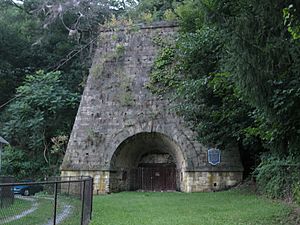Farrandsville, Pennsylvania facts for kids
Quick facts for kids
Farrandsville, Pennsylvania
|
|
|---|---|
|
Unincorporated community
|
|

The Farrandsville Furnace in 2012
|
|
| Country | United States |
| State | Pennsylvania |
| County | Clinton |
| Township | Colebrook |
| Elevation | 587 ft (179 m) |
| Time zone | UTC-5 (Eastern (EST)) |
| • Summer (DST) | UTC-4 (EDT) |
| ZIP |
17745
|
| Area code(s) | 570 |
| GNIS feature ID | 1192450 |
Farrandsville is a small, quiet community in Pennsylvania, USA. It's not a city or a town with its own local government. Instead, it's an unincorporated community, meaning it's part of a larger area called Colebrook Township.
Farrandsville is located in Clinton County. It sits on the north side of the West Branch Susquehanna River. You can find it about 4 miles (6.4 km) upstream from Lock Haven. Two small streams, Whisky Run and Lick Run, flow through this historic place.
Contents
The Story of Farrandsville
The community of Farrandsville was named after William P. Farrand. He was a representative for the Lycoming Coal Company. Mr. Farrand started the village in 1832.
Early Transportation: The Canal
Just two years later, in 1834, the West Branch Canal was finished. This canal reached Farrandsville, which was a big deal! It meant the village could easily get supplies and send goods to markets using canal boats.
Farrandsville became the very end of the canal. The canal was never built further upstream. During this time, a steamboat named Farrand even traveled on the West Branch Susquehanna River. It made regular trips as far upstream as Farrandsville.
The Famous Iron Furnace
In 1836, a group of investors from Boston decided to build a large blast furnace in Farrandsville. This furnace was completed in 1837. It was huge for its time, measuring 43 feet (13 m) square at its base and 54 feet (16 m) tall. It was one of the biggest furnaces in the United States!
The Farrandsville Iron Furnace used coke as fuel. Coke is a special type of fuel made from bituminous coal, which came from a nearby mine. The furnace also used a new technology called hot blast. This technology helped it produce a lot of iron. It made about 50 short tons (45 metric tons) of iron each week. This amount was second only to the Lonaconing Furnace in Maryland.
Why the Furnace Closed
Even though the furnace had local coal, it faced a big challenge. The nearest iron ore was over 100 miles (160 km) away in Columbia County. The cost of bringing in this ore, along with limestone (which is also needed for smelting iron), was very high.
This high cost, combined with money problems during the Panic of 1837, led to the furnace closing in 1838.
Other Industries in Farrandsville
Even after the iron furnace closed, other businesses kept Farrandsville busy. These industries thrived through the early 1900s. Some of the businesses included:
- A fire brick company
- A cigar company
- Several lumber mills
The Harbison-Walker Refractories Company from Pittsburgh bought the brickworks in 1902. They continued making bricks there until 1925. Later, in 1951, the company gave the historic iron furnace to the Clinton County Historical Society.
Images for kids



